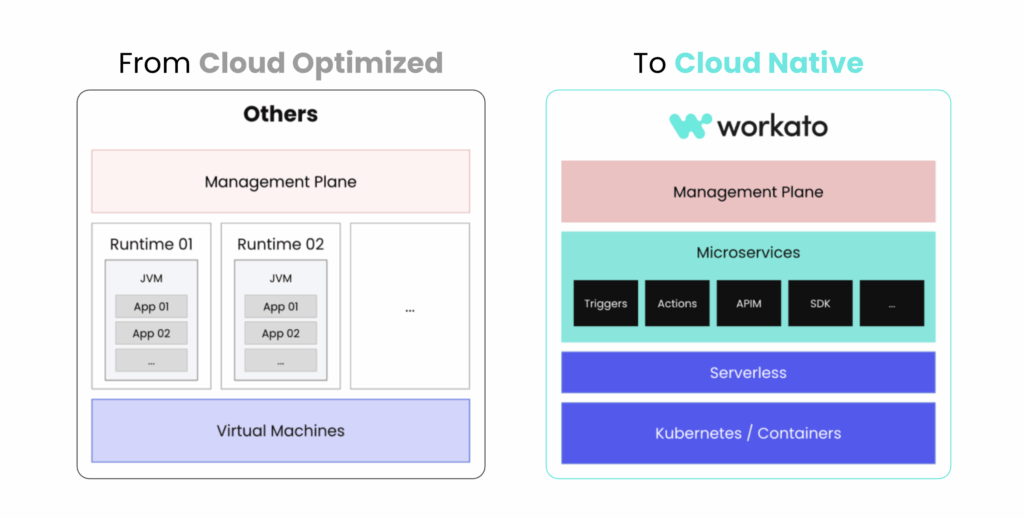When it comes to transformational enterprise platform migrations, few stories are as compelling as Samsara’s journey from MuleSoft to Workato. Vaishali Gandhi, Senior Director of Data Engineering, Integrations, and AI at Samsara, shared the inside story of how her team achieved faster, more scalable, and more reliable integrations—while empowering teams across the business.
Watch the full talk Vaishali Gandhi presented at WoW–the World of Workato.
Building a Modern Data Platform
Vaishali began by setting the stage:
“For the past three years at Samsara, we have built out an enterprise data platform that supports all business lines at Samsara. We’ve integrated our product usage data with business data as well.”
Her team’s responsibilities span integrations, data engineering, and AI. “What I love about what I do is building ground-up systems, making a difference to the bottom line.”
The Challenge with MuleSoft
When Vaishali joined Samsara, the company was already using MuleSoft. While full-featured, it wasn’t keeping up with Samsara’s pace of innovation.
“MuleSoft is a quite mature, very robust integration platform, but we felt that it was slow in innovation.”
Enter Workato
The push to evaluate Workato was an executive initiative that came from Samsara’s CIO, Stephen Franchetti, who had seen Workato’s impact at Slack.
“He proposed that I do some investigation and take a look at [Workato], because of its innovative nature… and it is very intuitive to use.”
After a successful proof of concept, Vaishali’s team kicked off the migration.
Large Scale Migration at Full Speed
The scale of the existing MuleSoft implementation would be no small feat to migrate:
“We had 48 integrated pipelines from point to point for all of our transactions, our order-to-cash being the most complex… 1 million plus order-to-cash transactions, 3.26 million distinct transactions.”
But the team was up to the challenge and results were eye opening:
“Our longest [integration with Workato] took one to two weeks… [On MuleSoft] the same initial build took somewhere around eight to ten weeks. That is a tremendous amount of time for the MuleSoft build compared to how quickly we implement the same solution with the Workato recipes.”
Workato is Cloud-Native, Serverless, and Scalable
The migration wasn’t just about speed. It was about embracing Workato’s powerful serverless architecture:
“We went from cloud optimized [with MuleSoft], to cloud native [with Workato]… The whole management of virtual machines is gone. Everything is microservices-based, and therefore, much faster and more efficient from the engineering perspective. We have a serverless implementation on Workato, so we’re not spending on infrastructure at all.”
Turning Skeptics Into “Believers”
Change is never easy, especially for engineers deeply invested in a legacy platform.
“I have over 100 years of MuleSoft [experience] on my team… It wasn’t easy to tell them, ‘Okay, you’re gonna move on to this new platform, something totally different that you’ve never seen, never done before.’”
But even the those with deep allegiance to MuleSoft quickly discovered the power of Workato’s modern enterprise platform:
“As someone who spent 10 plus years using MuleSoft, [my principal integration architect] admits that he was very skeptical at the beginning, but after some time working with Workato, first hand, he’s a believer.”
CLIMBING TO NEW HEIGHTS WITH WORKATO
According to Shrujal Patel, Manager of Data Integrations at Samsara, “What did it for me was the speed of development, the scalable costs, and the pace of the Workato Product Team’s innovation. [Workato] is a modern platform and a vendor that delivers.”
“As someone who spent 10+ years using MuleSoft, I admit that I was skeptical at the beginning but after some time working with Workato first hand, now I’m a believer.”
Extensible Recipes, Observability, and Zero Failures
Workato “recipes” were a revelation:
“The recipe’s business logic is completely decoupled from Workato execution runtime… so you don’t have to worry about server availability. Here, we are completely decoupled, so there are no conflicts.”
Fully Embracing Cloud Native
Workato leverages container technology thereby providing a lightweight, portable, and consistent environment for running the application, making it easier to manage and scale. This architecture allows developers to focus on business logic implementation with key operational concerns like guaranteed delivery and high availability handled by a robust distributed runtime, all deployed within containerized environments.
WORKATO’S MICROSERVICES-BASED RUNTIME ARCHITECTURE
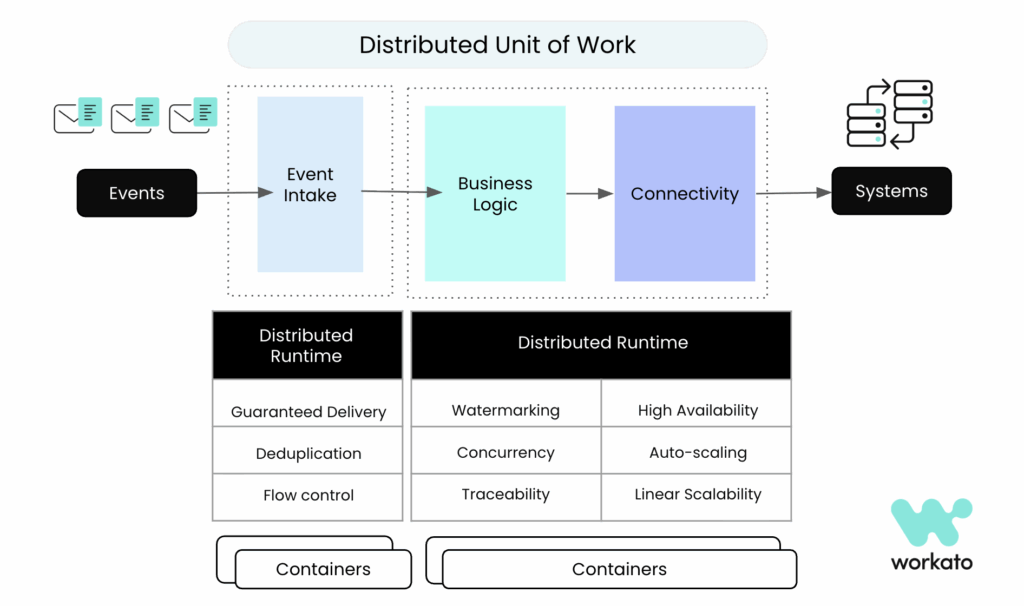
Vaishali went on to share “now that we’ve embraced Workato’s cloud-native platform, we are not limited by ‘server-affinity.’”
As with legacy platforms, server affinity between an application and runtime transfers the operational burden to the application developer, to consider factors like sizing, peak load estimation, performance, etc. Avoiding server affinity creates an auto-scalable infrastructure that constantly monitors the availability of “idle workers” to ensure the timely execution of every application event.
WORKATO’S AUTO-SCALABLE INFRASTRUCTURE
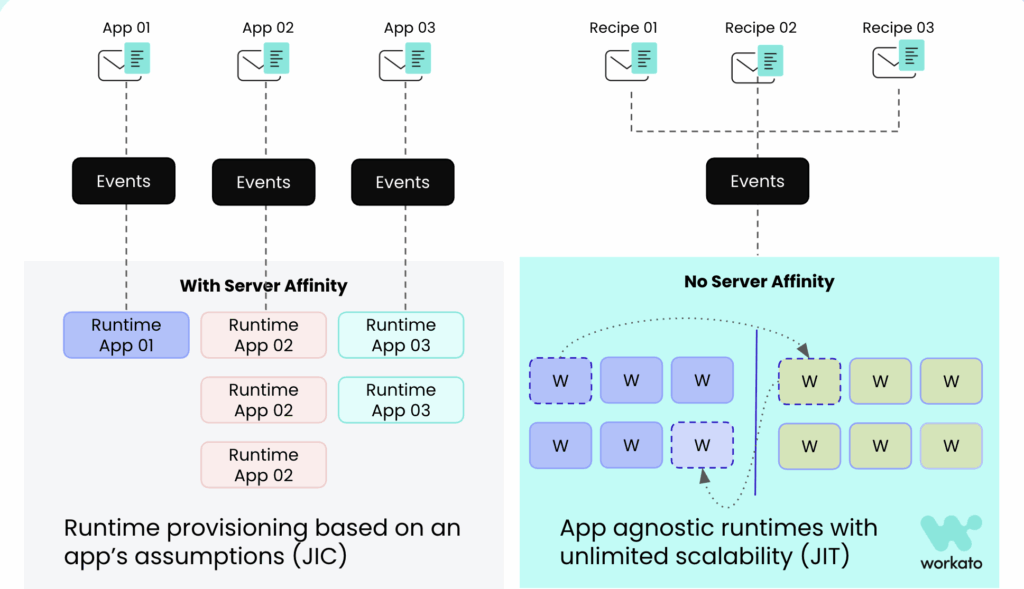
Extensible Recipes, Observability, and Zero Failures
Workato’s “recipes” were a game changer:
“The recipe’s business logic is completely decoupled from Workato execution runtime… so you don’t have to worry about server availability. Here, we are completely decoupled, so there are no conflicts.”
WORKATO RECIPES DECOUPLE BUSINESS LOGIC FROM EXECUTION RUNTIME

Workato’s Observability was another win:
“There is quite a bit of auditing out of the box… job history and job entries, zero downtime, connector upgrades… We are also taking these logs and pushing them into Splunk and creating additional data accuracy dashboards.”
And the reliability?
“We have deployed nearly a dozen projects in Workato… We have not had a single failure. Critical projects like implementing a brand new payroll system. We’re not talking about something that is trivial. We’re talking about something that impacts the entire organization. And we have not had a single failure period, not technically, not recipe-wise.”
2x Faster Development and Self-Service
The impact on productivity was dramatic:
“[Workato is] two times faster [than MuleSoft], and it has given us the equivalent of three FTE… The biggest selling point for me, for Workato, was the ease of use and the speed of development from an engineering perspective.”
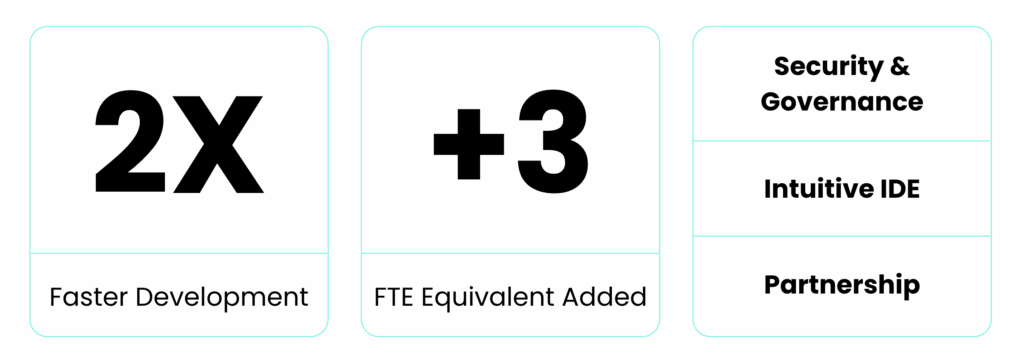
Workato’s intuitive interface enabled self-service across teams:
“These folks, these engineers, had never used an integration tool, period… The GTMS team also has two additional developers… and the corporate system has one person who’s working on Workato as well.”
Looking Ahead: Workato One and the Agentic Future
As Samsara looks to the future, Vaishali and her team are eager to build on their success by exploring the next generation of automation and Agentic AI with the Workato One platform.
“We want to go forward with having a Workato platform that serves multi-purpose across Samsara,” Vaishali shared. “My AI team is already scoping POCs for Workato One and the Agentic AI platform. We’re excited to see how these innovations can help us deliver even more value, faster, and empower teams across the business.”
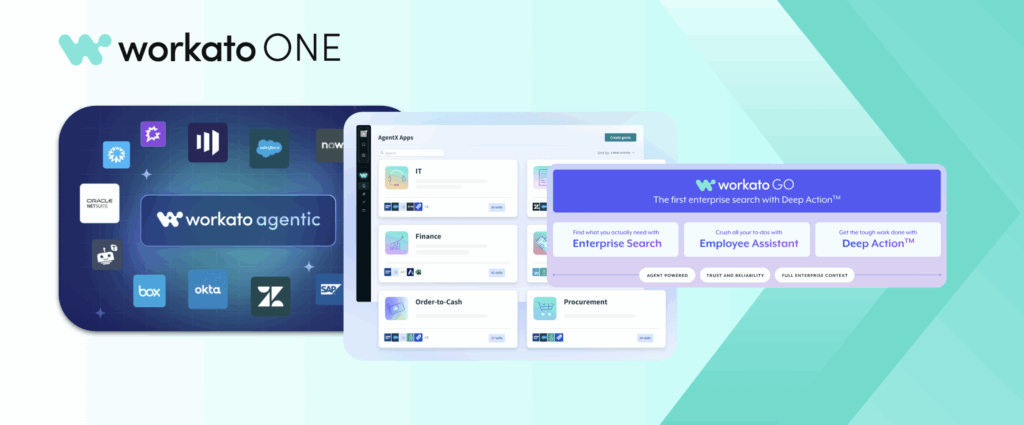
With Workato One, Samsara aims to take on new levels of automation, intelligence, and self-service, enabling teams across Integrations, Data Engineering, GTM, Support, IT, and Finance to move from integration to orchestration and from automation to true business agility.
To learn more about what Samsara is doing with AI Agents, see this quick clip with Samsara CIO, Stephen Franchetti.

